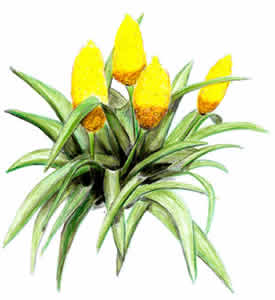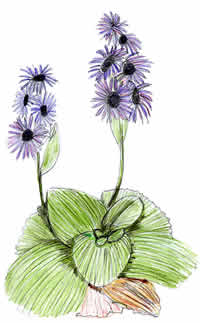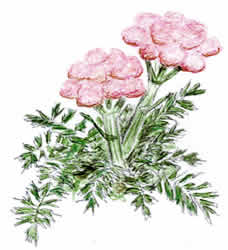|
Home > The
Explorers > Joseph Dalton
Hooker > Megaherbs
Joseph Dalton Hooker - The Megaherbs

First described by Joseph
Hooker while on the epic Antarctic voyage of the Terror and Erebus
under Captain
James Ross, these strange plants were not so startling for their
size, but for their size relative to where they grew. Named 'Megaherbs'
by Captain Ross, these unusual plants may not seem large when compared
to their tropical counterparts, but when you stop to consider that
they are growing on the Subantarctic Islands of New Zealand, they
do seem oddly large for the harsh climate they thrive in.
During the 1800's, to increase the chances of survival for possible
shipwreck survivors, many uninhabited islands were stocked with goats,
sheep, rabbits and other grazing animals, as a potential source of
food for the hapless victims of Antarctic storms. And where ships land,
rats inevitably follow. This led to the destruction of many wild habitats,
with little if any hope of recovery. Yet, seemingly against all odds,
they were brought back from the very brink of extinction only a few
years ago.
By 1993 a conservation program, initiated by the New Zealand government
in 1987, had successfully eradicated these feral populations on the
Subantarctic Islands. The bird population, having been decimated by
rats eating their eggs and young, recovered at an expected rate. However,
it was the re-emergence of the  Megaherbs that was most remarkable. Megaherbs that was most remarkable.
Whether these regenerated plants arose from the stunted survivors
of excessive grazing, or sprang anew from seed lying dormant for centuries
in the cold acidic soil, is still a matter for some research. The results,
however, cannot be disputed, as the islands have recovered with vast
fields of Megaherbs, growing and blooming in profusion during the short,
cold Sub Antarctic summer.
The soil is rich, although very acidic, as the volcanic ash, cool
temperatures, and low ambient light have produced thick drifts of moss
and lichens over much of the islands. Over aeons the Megaherbs have
adapted to these unusual conditions to such a degree that they will
not grow well elsewhere. Like so many island populations, the plants
of the Subantarctic Islands have developed their unique attributes
in isolation, and are now so dependant on the conditions they evolved
to suit, that there is little chance of growing these species elsewhere
in the world.
Of the many species of Megaherbs endemic to the Subantarctic Islands,
three of the most striking are profiled here:
Bulbinella rossii
Ross lily
Named by Hooker in honour of Captain Ross, Bulbinella rossii is one of the
few 'Megaherbs' which may be grown in some cool temperate gardens, although
bulbs and seeds can be difficult to obtain. The golden flower spikes have been
known to reach almost 2m (6ft) in height, but in their native habitat, rarely
exceed 1m (3ft).
Pleurophyllum speciosum
Campbell Island Daisy
These plants seemed to have impressed Joseph Hooker the most. After seeing
them for the first time, he wrote in his journal;
'...the most extraordinary is the Pleurophyllum
meadow, a community dominated by the large-leafed herbaceous composite,
producing a floral display second to none outside the tropics.'
The large leaves, like fans of pleated felt, form a rosette of up
to 1.25m (4ft) across. The flowers are typical of the daisy family,
and have dark maroon almost black centres, with ray petals ranging
from almost white to pink or purple.
Its nearest relatives are almost half a world  away, in South Africa and the Canary Islands, so how its ancient
ancestors arrived on the Subantarctic Islands is something of mystery. away, in South Africa and the Canary Islands, so how its ancient
ancestors arrived on the Subantarctic Islands is something of mystery.
Anisotome latifolia
Known as the Campbell Island Carrot, this Megaherb bears only a passing resemblance
to its cultivated cousin. The densely packed flower heads can be as much
as 50cm (20in) across, and are held up to 1m (3ft) above the feathery foliage
on remarkably sturdy stems.
For further information on the recovery of the Subantarctic Islands,
or to even join an expedition to see them, there is no better place
to start the Department
of Conservation - Te Papa Atawhai, New Zealand site.
Next: Sir Joseph Dalton Hooker - The Himalayas Sir Joseph Dalton Hooker
Sir William Jackson Hooker
For more detailed
information on the extraordinary life of Sir Joseph Dalton Hooker...
Top |

